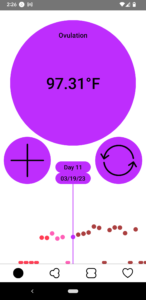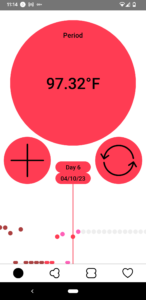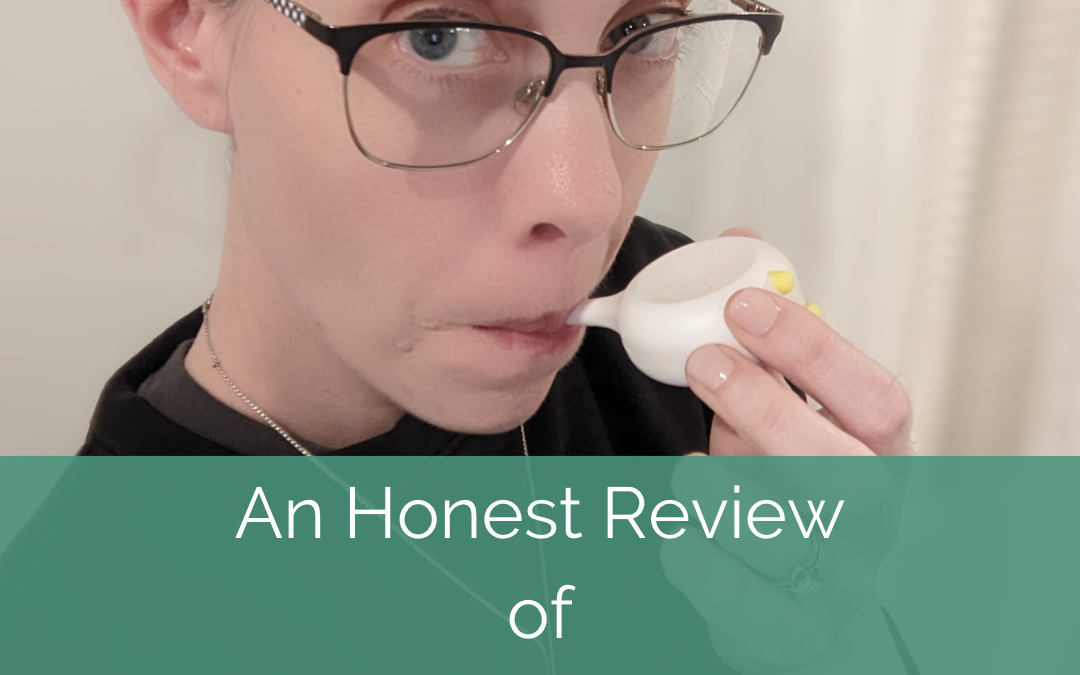An Honest Review of Teena

How Natural Family Planning Helps us Practice the Christian Art of Discernment
March 17, 2023I don't usually post reviews on the blog: I typically stick to more esoteric sorts of theological meanderings. But I recently had the opportunity to try out Teena- a thermometer and cycle tracking app by the same company that created the Daysy, just marketed and repackaged for teens.
Because I have written a charting book for teens and do work with a number of families who have questions about teen cycles, I was very excited to give this new device a try. I wanted to know if it would actually be a helpful resource to recommend!
To be completely transparent up front: I did receive a free device from Teena (thank you!) in order to give this review. But I hope you'll see that my thoughts shared here are truly representative of my experience and my recommendations.
So let's begin.
First of all:

In-app screen shot showing temp, ovulation assessment, and graph representing temperature readings and color-coded cycle assessments for the cycle
WHAT IS TEENA?
Teena is an oral basal body thermometer, coupled with an app. You use the thermometer in the same way you would use a regular oral BBT device: you turn it on to take a temperature measurement upon waking first thing in the morning, placing the thermometer firmly under your tongue. Teena reads for about 30 seconds. There is no place to view the measurement directly on the thermometer, so in order to retrieve your temperature you need to sync the thermometer via Bluetooth to the app. After you have synced the thermometer, you will get a reading for the day, which the app displays as a dot, with a color value that represents the app's assessment of your cycle phase.
In other words: Teena is a system of cycle tracking, tied to a specific device and app. There is no interpretation schema that a teen needs to learn or apply in order to use Teena.
By simply marking bleeding days and tracking temps, the Teena app will use a girl's personal biomarker data combined with its proprietary interpretive algorithm to give her information about:
- cycle days
- cycle phases
- temp shift
- ovulation day
- predicted period dates in the future
WHAT FEATURES DOES THE APP HAVE?
Along the bottom screen of the app, you'll see a menu with four different icons.
The circle shows the calendar for the current cycle (the image above).
The three circles are combined analysis for the data you've provided so far: cycle stats like average length of cycle, length of period, etc.
The third icon is the "Magazine," which is actually my favorite part of the app. In the Magazine section, you'll find lots of mini-articles which teach a lot of great information about periods, phases of the cycle, anatomy, and general pubertal development. It is here that girls learn about why BBT can identify ovulation, how cervical fluid is a healthy sign you can observe about your body, and that periods in the first few years will probably be irregular AND include a fair number of anovulatory cycles. In general, the tone of the magazine is affirming of changes, informative, and welcoming of all the honest (sometimes embarrassing) questions girls have about puberty including acne, yeast infections, and more. Overall, I think the Magazine is pretty well done!
The fourth icon, the heart, is just your profile settings and help center.
What I want to point out is a feature which I am really excited is NOT in the app: a chat/forum!!!!! I've tried out a number of "teen period apps" that have chat features which, from a parental point of view, just make me want to cringe all over. No thanks. I appreciate the privacy that Teena is offering here.
Another thing the app does not have is a subscription fee. You purchase the device, and that's it! Hooray!
I'm also really happy that the app is not marketing itself as any sort of birth control. It doesn't attempt to identify a fertile window, or to give a twelve year old girl the option to mark intercourse, oral sex, or masturbation (yes, there are apps that do this!). Teena is JUST about tracking cycles to identify ovulation and help girls better understand their bodies. I LOVE that!
Now, let's talk about recommendations.
WHO IS TEENA GOOD FOR?
Despite the emphasis in the Magazine on preparing girls to understand the irregularities of teen periods and the prevalence of anovulatory cycles, the app functions best for girls who are already cycling regularly. In the first few years after starting her period, a girl's HPO axis (the communication channel between her brain, pituitary glands, and ovaries which is responsible for coordinating the hormones to make up a cycle) is relatively immature. It needs time to build up strong connections, and this may just take a few years.
Anything with a predictive feature will be ill-equipped to serve a population that experiences irregular bleeding patterns. So yes: once it detects a temp shift, Teena will apply its algorithm to predict the next bleed. BUT: it can't warn you about when an anovulatory bleed might happen
an immature HPO axis will often result in irregularities with cycle phases, meaning a young girl's luteal phase may not be a consistent length like we expect with a more mature HPO axis
So, in terms of utility, I think the actual charting feature is best designed for older girls who already have more regular cycles. I worry that the predictive features might produce more anxiety in younger girls who aren't yet regular, because they will feel that there is something "wrong" if they are bleeding when the app didn't predict a bleed, or if they don't get a bleed when the app thinks they should.
Teena also would not be a robust charting option for girls who wanted to include cervical fluid observations or interpret their own temperature shifts. The only options for tracking that are currently included in the app are: bleeds, "emotions" (which also includes things like acne), and temperature. So if someone wanted to chart other things, I would recommend just going for a different app with a less expensive BBT thermometer (launch price for Teena is $99, with regular price currently listed as $199 USD).
Another side note about the thermometer itself: Teena would be very hard to use for anyone who is visually impaired because the device does not beep like other thermometers— it relies on a flashing light to tell you when the device is on, reading, and finished reading. This means that a girl who is blind could not use the device herself to take her temp, unlike a more standard thermometer with memory recall, which would still require sight assistance to retrieve the data, but not to collect it. I am also mildly photosensitive and found it very unpleasant to have a light flashing right near my eyes first thing in the morning. Anyone who is prone to photosensitive seizure activity might want to avoid this device.
WHAT COULD TEENA IMPROVE?
I actually want to give the Teena development team a huge shout out, because I approached them with some of my concerns and they were very receptive. They have shared that the app is still in its first stages, and they are working to make improvements. So I am encouraged by that attitude and hope it yields a really robust and helpful app for teen girls in the future! We shall see.
Just for the record, here are the things I think Teena could improve, even just slightly, that might make me change my mind and give a much stronger recommendation to families.
 Bleeding Assessments
Bleeding Assessments
Currently, the app just has a place to mark any bleeding as "Period," with an intensity ranging from 1-4 drops. I was curious about whether the app would accept my interpretation of a new period starting before Teena had identified ovulation with temps (side note: if ovulation hasn't happened, it's not a real period!) To my chagrin, when I entered a bleeding day a few days after my previous period days, the app simply took the info. It didn't start counting a new cycle, but it did still say that I had my period... again. I believe that the algorithm will ignore one day of bleeding in this way, but if I had 3 or more days, it would start a new cycle.
This is simply inconsistent with all of the great info they already have in the magazine about anovulatory bleeds, and would be a very quick fix. I'm hopeful that they will change that label from "Period" to "Bleeding" and then add an interpretive feature to be able to mark "Period" as bleeding following a confirmed temp shift.
Another quick addition would be the option to mark spotting, since spotting patterns can be hugely beneficial in any cycle diagnostics.
Add Cervical Fluid Tracking
Teaching girls how to identify cervical fluid patterns can be helpful in equipping them to recognize yeast infections and assess spotting. Since the app isn't focused on charting for fertility, there's no need to burden the girls with categories of fluid relative to fertility status... just give them some options for key words to identify the fluid so they can track alongside temps. Eventually, as cycles get more regular, they will be able to see those fluid and temp patterns beginning to line up! It could be a great way to help girls see the way their cycles are maturing as they grow.
Make Predictive Features Optional
I understand that their proprietary algorithm is a HUGE part of what Valley Electronics brings to the table in terms of femtech. You don't want to just jettison that, and I think it's smart to repackage what they worked on with the Daysy to meet the needs of a new demographic. But... I'd love a feature which lets you turn off predictions about future periods. This would make it easier and more comfortable for girls in the first few years of cycling to onboard with the app, and allow their experience to grow as their bodies mature. The question at that point, however, is whether Teena might also want to change the interface so it's easier to see an actual temperature graph at the bottom, rather than just a series of unlabeled dots. This would allow girls to begin visualizing temp shifts more clearly, even if they didn't want or need to calculate them manually.
THE BOTTOM LINE
I'm excited that a femtech company has recognized the value in teaching girls to chart their cycles for health: this is much more than a period tracker. But the strength of Teena, I believe, currently lies heavily in the Magazine component, where all of the educational articles are. The app just doesn't feel like it was designed for teens in terms of functionality (in terms of graphics, yes, it's definitely geared towards teens)--and that could possibly be because it's an adaptation of a previous charting system (Daysy) that was built for fertility interpretation. I'd like to see more consistency between the teaching modules and the way the app functions. If they manage to achieve that in subsequent iterations, I think Teena could be a great charting option for girls!
BONUS NOTES:
Language
I am always very sensitive these days to the type of language used surrounding periods and gender. For a company that is not Catholic and may want to appeal to users who have made body modifications, I actually think Teena made a good choice to sidestep that mess altogether. All of the articles speak directly to "You," the user. "Before your first period..." instead of "Before a girl's first period..." or "Before a menstruator's first period..." There is no agenda I can find in the app beyond education and utility for cycle assessment, and I wouldn't worry that girls would be confused by the language used.
Images
The images used for teaching in the Magazine portion are wildly-colored and cartoony. Anatomical images are likewise slightly abstract and not inherently troublesome. They don't appeal to my thirteen-year-old, but that's just because it's not her style. I could see the graphics potentially appealing to other girls her age. The only inclusion I question is a separate feature on clitoral anatomy, which is simply a diagram without any additional information.

